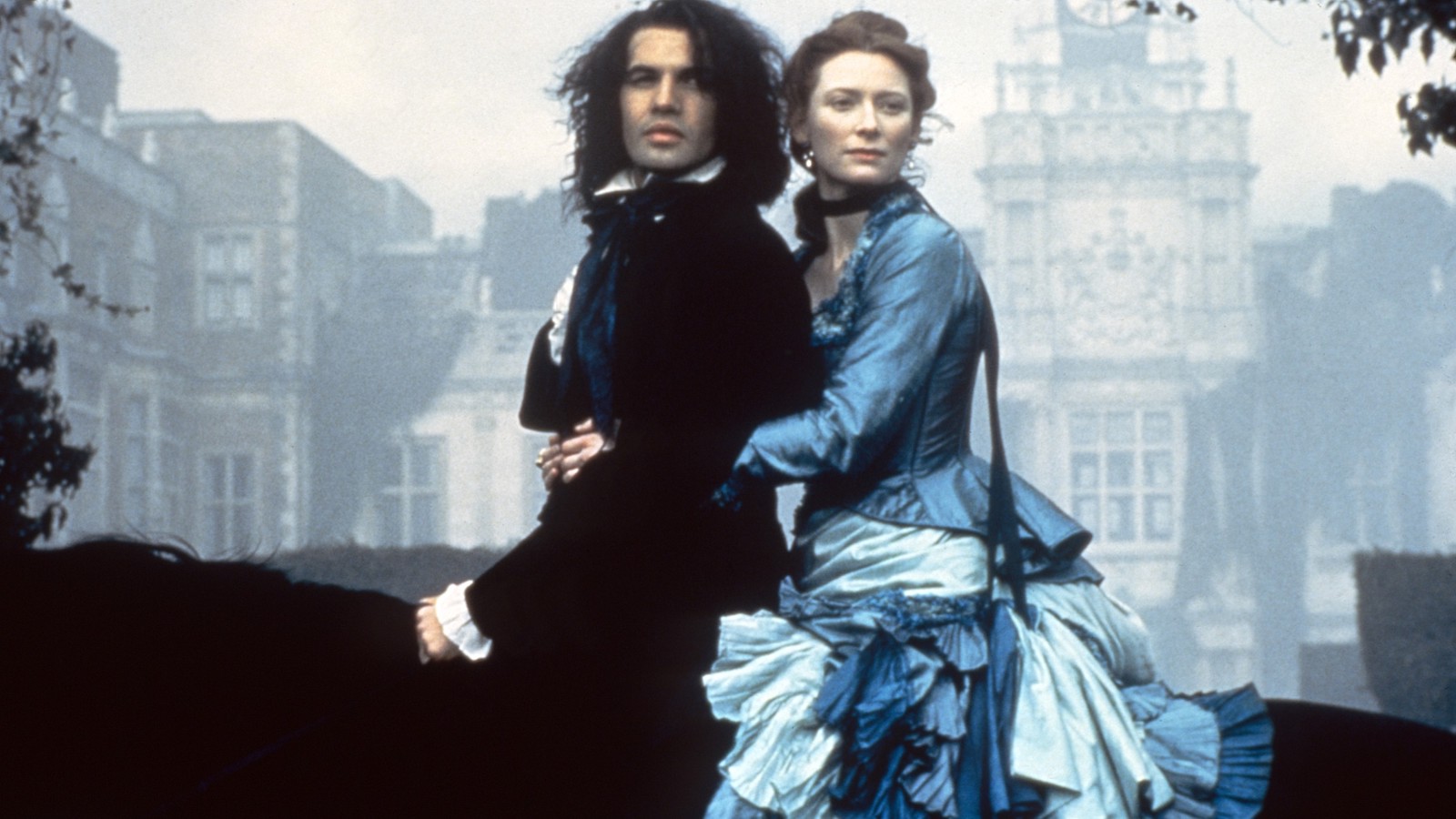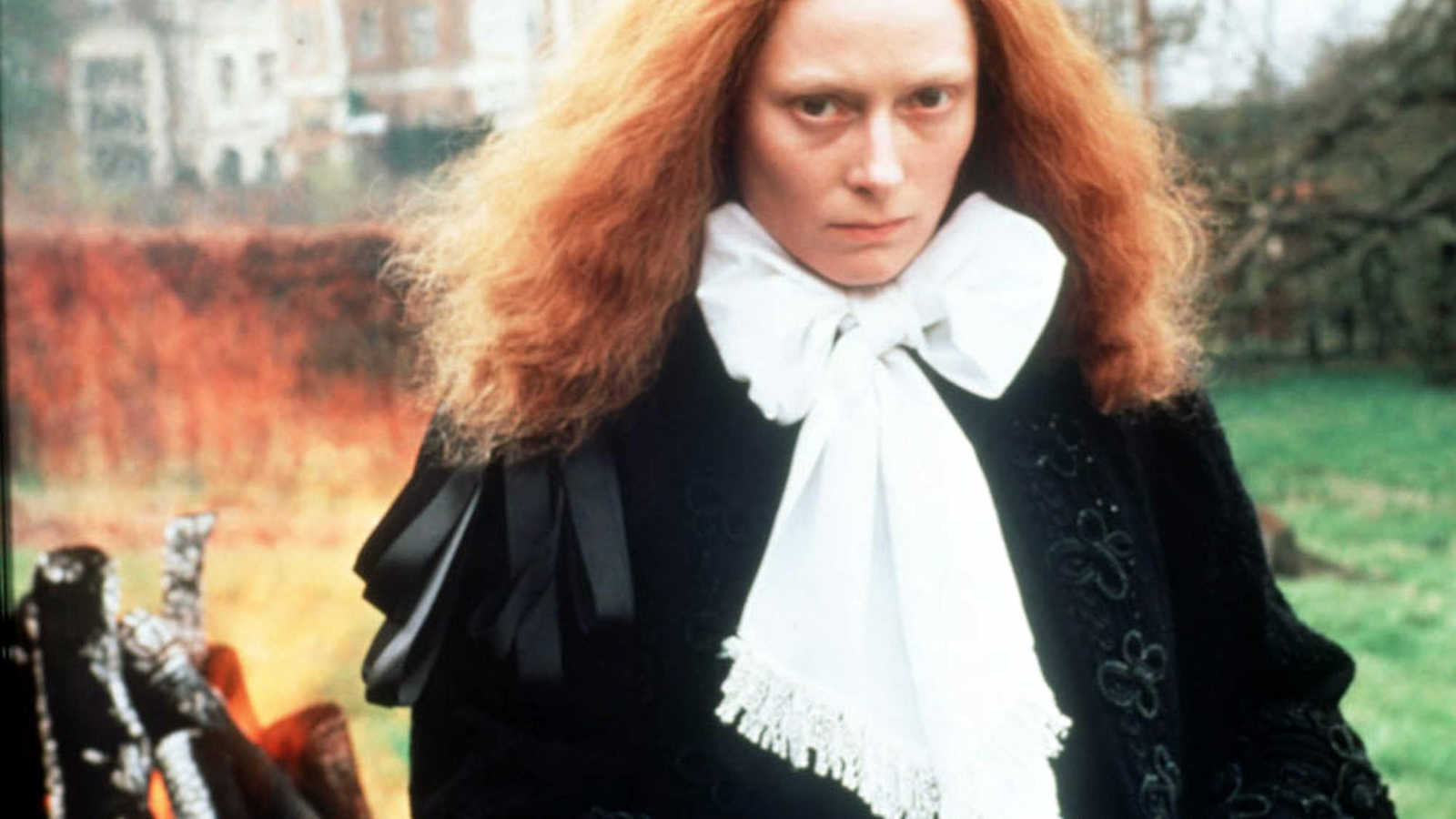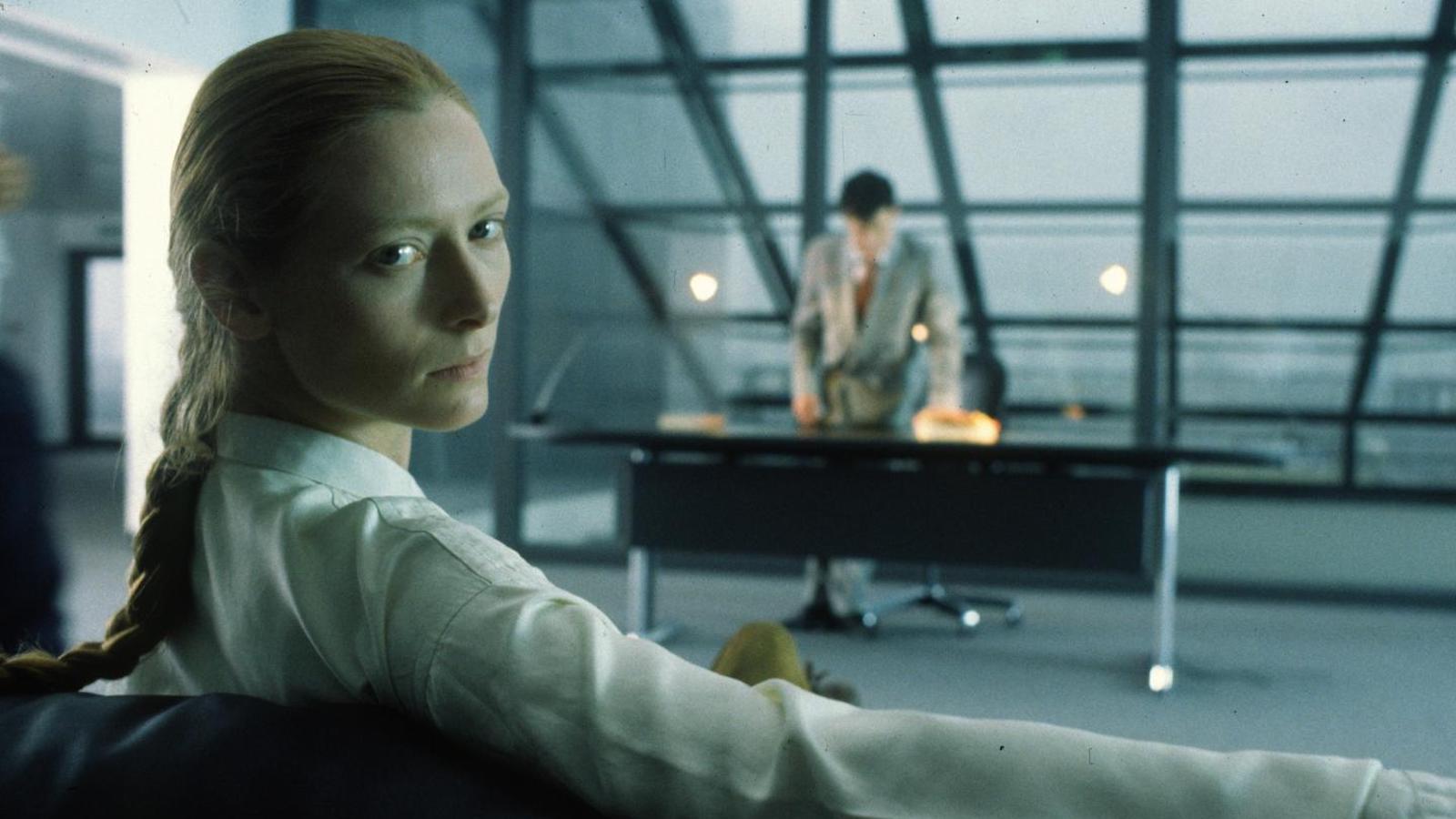Tilda Swinton Looks Back at Orlando
Interview
Tilda Swinton Looks Back at Orlando

Interview
BY
Isobel Harbison
An interview with Tilda Swinton.
Newly restored in its 30th anniversary year, Orlando plays at Metrograph from October 7, as part of Yes: The Films of Sally Potter. Meanwhile, revisit Swinton’s roles in films like Caravaggio and The Last of England, part of Derek Jarman x9, now streaming on Metrograph At Home.
Released in 1992, Orlando is a film directed by Sally Potter, based on a novel written by Virginia Woolf, starring Tilda Swinton in the title role. Orlando’s life spans four centuries, beginning around 1600 as a young man favored by Queen Elizabeth I who commands him to never fade or grow old; in return, she gives him wealth and land. Accepting, he proceeds through the years without aging, appointed the following century as ambassador to England in Constantinople. Here, after a battle followed by a prolonged sleep, Orlando awakes serene, now a woman. The film rounds off with her reflections on lived time, set in Potter’s present day.
Orlando was a critical and commercial success, and proved a career threshold for Swinton. In character, she conveys a constant intensity of presence, a complex of relations, and—despite lavish sets and sumptuous costuming—a refusal to gestural excess, to melodrama. The production coincided with her Best Actress award at the Venice Film Festival for Isabella III in Edward II (1991) by Derek Jarman, her most formative and frequent collaborator until that point. After he cast her in Caravaggio (1986), her debut film, she found her stride, becoming active among a motley of independent filmmakers—including Potter. Alongside her, Swinton found new form, performing to camera while also pioneering and panhandling behind the scenes to aid production, as she explains in our email exchange below.
After Orlando, Swinton would go on to explore new territories in a career where a facility for active collaboration, a palate for script, an instinct for angles, and a willingness to play has set her apart from other actors. Like Woolf’s Orlando who, “was no lover of garden flowers only; the wild and the weeds even had always a fascination for him,” Swinton’s taste for playmates is broad. She continues to tend Hollywood’s flora, though she thrives among untamable climbers, too: artists John Berger, Cornelia Parker, Apichatpong Weerasethakul, to list just a few. Her fidelity to collaborators is matched by her enduring loyalty to productions. This year marks Orlando’s 30th anniversary and the cinematic re-release of its 4K restoration promising viewers exhilarating viewing, a prime example of what she describes as the “verve set by those that went before.”
ISOBEL HARBISON: In an article from 1993, Sally Potter recalls Orlando’s origin—taking you to Knole, the country house that inspired the ancestral home in Woolf’s novel. You were dressed in Victorian costume and she whipped out her Nikon camera to take pictures of you, to the surprise of uninformed grounds staff. Is this how you remember this project beginning?
TILDA SWINTON: For me, the project began when I met Sally for tea in a cafe in London where she put a copy of Virginia Woolf’s book down on the table in between the buns. The moment you describe was several months further down the road. Sally and I forced ourselves to realize that there was no “evidence” that we could show potential partners and investors that we might be onto something with this idea, which promised to be more expensive than anything either of us had been involved with before. We decided that we needed just even just a handful of images to whet the appetite. So, we hired two costumes from a theatrical costume house—a Victorian dress and an Elizabethan doublet and hose—and we set off for Knole in my little car. Those images ended up in an exquisitely bound book which—long before the days of “decks” or easily accessed websites or even mass-produced leaflets—was handed out to potentially interested parties on a fundraising trip to Cannes. Recently, I tracked down two copies, Sally’s and mine, for a recent exhibition I curated around Orlando [Aperture, New York, 2019]. Presumably all the others were cast aside like so many post-film festival bumph inevitably is…

"the film, for me, has often appeared as a kind of dance, with only sparing moments of hiatus and pause. It even felt that way as we shot it."
IH: Potter has said, “making a film is choreographing the relationship between the camera, the actors, and the space.” There are many restrictions in shot, furniture in the houses, mazes in gardens, and these are particularly obstructive when Orlando becomes a woman, mirrored by the corseted costuming. What was your experience of Potter’s choreographic approach?
TS: I look at Orlando now and I see how completely organized it is, spatially, thematically, rhythmically. And I suppose it was always part of the atmosphere of Sally’s work that there would be something somehow gathered and meted out in the way the shot, the scene and the narrative as a whole unfolded. At the time, this wasn’t something I was particularly surprised by: we were telling a tale over 400 years within roughly 90 minutes and we had to keep things brisk. Even at the stage of developing the script, we were keenly aware of the need to work within a series of coordinate codes in order to establish a forward moving feeling. I suppose, with hindsight, this is one of the reasons Sally was so much the perfect person to make this film. Her commitment to flow and constantly morphing energy is so closely in sync with Woolf’s own project. And the film, for me, has often appeared as a kind of dance, with only sparing moments of hiatus and pause. It even felt that way as we shot it.
IH: When asked about why she cast Billy Zane as Orlando’s husband Shelmerdine, Potter identified Zane’s strength of presence, his “slightly androgenous beauty” and his “upright bearing,” which also brings to mind your performance. And alongside you both, there is great delicacy in other cast members’ portrayals—Quentin Crisp as Queen Elizabeth I is devastatingly tender, for example. Was there a conversation among you about playing characters across or beyond gender, and the sensual possibilities of that?
TS: This sense of fluidity and somehow flexible nature was something Sally, Christopher [Sheppard, Orlando’s producer] and I discussed a fair bit in approaching the casting of all the people involved. We were always drawn back to those who held a sort of openness in their presence. The somewhat robust and lively beauty of Charlotte Valandrey, Billy Zane’s softness and twinkle, the incomparably regal and exquisite profile of Quentin Crisp, surely intended for the coins of a realm many of us consider home…
But beyond these appreciations, we never actively spoke about putting any actual effort into bumping up this sensibility. The understanding was that this fluidity was innate and effortless and—as always—we were passionate about avoiding the performative or fake.

IH: Potter has said that after her previous film, The Gold Diggers (1983), she wanted people to be able to engage with her work at “the most complex and subtle” level. Watching Orlando now, it seems to offer the escapist pleasure of a historical epic, while alternatively offering a poetic exploration of how identity might feel in tension with class or state, with inheritance. Can you reflect upon Potter’s original goal and how you see the film now?
TS: I saw the film most recently in a circus tent at Glastonbury where I have the honor to co-curate the cinema program during the festival. I hadn’t seen it for several years and was sitting leaning against hay bales with an audience largely made up of people almost certainly not born when we made it. What I saw was something hypnotically beautiful in terms of its imagery, not only the shots and the impact of its soundtrack, but also, its environment: an abundance of flowers, velvets, brocade, jewels, gilded furniture, all the paraphernalia of the aristocratic landscape. I remember so clearly Sally and I chewing (for what seems now like interminable lengths of time) the vexed question of how to set a film in the milieu of great wealth, inherited privilege and the unavoidable glamour of all the trappings of the owning class, while at the same time being determined to make a film about spirit, about surviving inheritance to live present and responsive and beyond the reach of the inequalities bound up in class and chauvinism.
We decided to build the film on the spirit of Orlando, solo, outside of any particular time or circumstance, and when I see the film now, I see this as a wise move. There is no investment for the audience in keeping Orlando bound to the landscape of their birth: in a significant sense, on the contrary, we are invested in the growth and emergence of Orlando in spite of the circumstances of their early life. So many stories that set themselves in similarly heraldic environments declare themselves from the very first as more interested in the perpetuation of property than human lives lived—Downton Abbey: the clue is in the title, there are many others…
Orlando is the journey of a solitary soul, a person respondent to the turns in the individual road of their unique life. Just as any of us might recognize our own lives to be. As such, I believe this is the key to the film’s—and Woolf’s book’s—eternal life. It is a fantasy, employing all the make believe of a fairy tale we might any one of us be enchanted by, but for all that, a very practical legend of a spirit in motion, growing up before our eyes. And becoming REAL.

IH: You were highly involved in Orlando since its inception, not only before the camera but in other ways, and at later intervals. What difficulties or challenges did you face, and how have you overcome them?
TS: The way in which I was privileged to work alongside Sally on Orlando has informed and influenced the way in which I have worked as a filmmaker ever since. It was the first fully immersive developmental process I had the experience of being involved in and I draw on the experience of it pretty regularly. What Sally and Christopher [Sheppard] embarked upon in 1987/8 when I first became involved was nothing short of kamikaze in terms of commitment, ambition and downright pioneering. We were profoundly inexperienced in almost every area in which we needed to operate in order to get a film of this scope and scale financed and crewed. We had nothing but our—shared—vision of the experience of the film in our heads. And we really liked each other. We piece by piece gathered fellow travelers like panhandlers sift for nuggets of gold. We blagged our way into high-level meetings about money and tried not to gag at the numbers. We spent money we didn’t have on clothes to look presentable while hustling. We gee’d each other along every step. We kept the faith. And then, we started shooting and we didn’t stop until we were finished. To gather together every few years to represent this work is one of the great joys and triumphs of our lives. Zero hardship, maximum gratitude.
IH: The cinematic re-release of this film coincides with its restoration and its 30th anniversary. What is the significance and potential impact of such an endeavor with works of this period and caliber—not only for filmmakers and cinephiles but for producers and distributors, too?
TS: There is no doubt that the opportunity to show a film made for the cinema—long available on smaller screens—once again in theatres and on big screens is a seriously powerful gesture. It reboots the original impact of the film itself and places it into a new moment for new audiences, new generations and a new historical and cultural context. It also renews the contract of faith between producers and distributors and the significant destination that is the big cinema experience. I have always believed that there is no such thing as an old film. This is nowhere more true than in the dark of the cinema before the projector starts up. Time bottled unspools on the big screen like a magic trick. And like with Orlando, miraculously there is no age, we are, as Woolf intended, transported instantly into the present moment of when those images were recorded.
Every time a distributor has the courage to rerelease such a film, especially from a moment in independent filmmaking history such as the 1980s and 1990s, when filmmaking practices were so vibrant and inspiring, they contribute massively to the culture of cinema and should be garlanded with grateful praise.
"We blagged our way into high-level meetings about money and tried not to gag at the numbers. We spent money we didn’t have on clothes to look presentable while hustling. We gee’d each other along every step. We kept the faith."
IH: Yesterday, I asked Lynn Hershman Leeson what it was like to collaborate with you. She replied, “It was not work, it was pleasure and invention and improv. Our work began around 1996, just after Orlando. We had the same sense of humor and irreverence and enjoyed the shifting stories we invented despite veering from the script. It was pure magic.” You have teamed up with some incredible artists from the beginning of your career. What pleasures have these collaborations brought you?
TS: The practical magic of working in fellowship with people I love and admire—and artists I am inspired by—is something I have been devoted to sustaining in my life ever since I first started working with Derek Jarman in 1985. There I learned the profound joy of working collectively, in the security of shared values and adventures. This accord is the foundation stone of my working practice. It has led me to the side of artists as extraordinary and resonant as Lynn Hershman Leeson, Joan Jonas, Doug Aitken, Apichatpong Weerasethakul, Bong Joon Ho, Joanna Hogg, Pedro Almodóvar, John Maybury, Tim Walker, Jim Jarmusch, Olivier Saillard, Lynne Ramsay and many, many more.
IH: The final image of the film is of present-day Orlando with her daughter (played by Jessica Swinton), who holds a camcorder as she plays in a field. Jimmy Sommerville appears as an angel and plays us out with a song of the future, advising letting go of the past. You have been a vital force in cinema, bridging a great range of artists and directors across generations. Advice for the young filmmakers then, for us to conclude and them to proceed?
TS: To know that, in the essential, you need no advice from anybody. To trust your gut and know that your value to the culture is as an original voice and therefore to trust your own instinct implicitly. To immerse yourself in the fellowship of over a hundred years of filmmaking and hold fast to the example of spirit and verve set by those that went before. To work with those with whom you feel safe and happy. To dance with your crew and make merry whenever possible.
Isobel Harbison is an art historian and lecturer at Goldsmiths, University of London. Her book Performing Image was published by The MIT Press in 2019.
